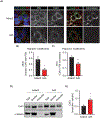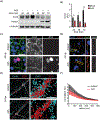Adenovirus targets transcriptional and posttranslational mechanisms to limit gap junction function
- PMID: 32485054
- PMCID: PMC7501180
- DOI: 10.1096/fj.202000667R
Adenovirus targets transcriptional and posttranslational mechanisms to limit gap junction function
Abstract
Adenoviruses are responsible for a spectrum of pathogenesis including viral myocarditis. The gap junction protein connexin43 (Cx43, gene name GJA1) facilitates rapid propagation of action potentials necessary for each heartbeat. Gap junctions also propagate innate and adaptive antiviral immune responses, but how viruses may target these structures is not understood. Given this immunological role of Cx43, we hypothesized that gap junctions would be targeted during adenovirus type 5 (Ad5) infection. We find reduced Cx43 protein levels due to decreased GJA1 mRNA transcripts dependent upon β-catenin transcriptional activity during Ad5 infection, with early viral protein E4orf1 sufficient to induce β-catenin phosphorylation. Loss of gap junction function occurs prior to reduced Cx43 protein levels with Ad5 infection rapidly inducing Cx43 phosphorylation events consistent with altered gap junction conductance. Direct Cx43 interaction with ZO-1 plays a critical role in gap junction regulation. We find loss of Cx43/ZO-1 complexing during Ad5 infection by co-immunoprecipitation and complementary studies in human induced pluripotent stem cell derived-cardiomyocytes reveal Cx43 gap junction remodeling by reduced ZO-1 complexing. These findings reveal specific targeting of gap junction function by Ad5 leading to loss of intercellular communication which would contribute to dangerous pathological states including arrhythmias in infected hearts.
Keywords: adenovirus; connexin; gap junction; myocarditis; β-catenin.
© 2020 Federation of American Societies for Experimental Biology.
Conflict of interest statement
DECLARATION OF INTERESTS
The authors declare no competing interests.
Figures








References
-
- Unwin PN, and Zampighi G (1980) Structure of the junction between communicating cells. Nature 283, 545–549 - PubMed
-
- Vozzi C, Dupont E, Coppen SR, Yeh HI, and Severs NJ (1999) Chamber-related differences in connexin expression in the human heart. J Mol Cell Cardiol 31, 991–1003 - PubMed
-
- Kanagaratnam P, Rothery S, Patel P, Severs NJ, and Peters NS (2002) Relative expression of immunolocalized connexins 40 and 43 correlates with human atrial conduction properties. Journal of the American College of Cardiology 39, 116–123 - PubMed
-
- Poelzing S, and Rosenbaum DS (2004) Altered connexin43 expression produces arrhythmia substrate in heart failure. Am J Physiol Heart Circ Physiol 287, H1762–1770 - PubMed
Publication types
MeSH terms
Substances
Grants and funding
LinkOut - more resources
Full Text Sources
Miscellaneous

